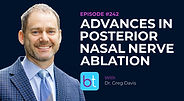BackTable / ENT / Podcast / Episode #109
Cryotherapy for Chronic Rhinitis and Nasal Congestion
with Dr. Jeff Suh
In this episode of BackTable ENT, Dr. Shah interviews rhinologist Dr. Jeffrey Suh (UCLA) about cryotherapy as a new treatment for chronic rhinitis.
This podcast is supported by:
Be part of the conversation. Put your sponsored messaging on this episode. Learn how.

BackTable, LLC (Producer). (2023, May 9). Ep. 109 – Cryotherapy for Chronic Rhinitis and Nasal Congestion [Audio podcast]. Retrieved from https://www.backtable.com
Stay Up To Date
Follow:
Subscribe:
Sign Up:
Podcast Contributors
Synopsis
First, the doctors discuss the typical presentation of a patient with rhinitis. Although all rhinitis patients present with a chief complaint of a runny nose, there are different subtypes of rhinitis, such as allergic rhinitis, gustatory rhinitis, and exercise-induced. Environmental exposures, duration of symptoms, and the presence of other symptoms should be elicited, as differentiating between allergic and non-allergic rhinitis changes treatment options. Next, Dr. Suh explains how he performs a physical exam in rhinitis patients. He uses a rigid endoscope to make sure there is not another cause of rhinitis. He is sure to premedicate patients with a lidocaine and Afrin nasal spray before using the endoscope. CT scans of the sinuses may be helpful if patients have drainage, polyps, or notable inflammation.
In general, Dr. Suh will pursue medical treatment options before considering procedural options. For allergic rhinitis patients, he educates patients about understanding their triggers for allergies and prescribes nasal steroid sprays and antihistamines. In non-allergic rhinitis patients, he recommends ipratropium bromide, which can also be used as a trial to see if cryotherapy would resolve their symptoms. He notes that sprays need to be used for at least 1 month before they show effects and that they should be used 30 minutes before trigger exposure for allergic rhinitis patients. He does not think that saline rinses help much with rhinitis, as they contain no medications to reduce swelling and dampen nerve stimulation.
Next, Dr. Suh explains two procedural options for chronic rhinitis: radioablation therapy and cryotherapy. Both procedures have similar success rates, but he prefers to use cryotherapy in patients with non-allergic rhinitis who have a positive response to ipratropium bromide. The procedure involves inserting balloon a into the middle meatus of the nasal cavity and in order to deliver liquid nitrogen to the nasal mucosa overlying the posterior nasal nerve. He explains different considerations for performing cryotherapy in the office versus in the OR. He also explains his anesthesia protocol and how to mitigate the common post-operative complaint of an “ice cream headache”, which he prophylactically treats with gabapentin. Radiofrequency ablation with the RhinAer procedure also targets the posterior nasal nerve, but it has other complications, like damaging other nerves that allow for the tearing of eyes. He chooses the cryotherapy option more often because it does not require as good visibility as the radiofrequency ablation therapy does.
Finally, he explains his postoperative care regimen which includes starting the patient back on their usual nasal sprays. His patients take 2 weeks to see results, and cryotherapy is effective in 80% of his patients. He notes that patients with recurrent rhinitis may need recurrent treatments.
Resources
Stryker ENT
https://www.stryker.com/us/en/portfolios/medical-surgical-equipment/ent.html
Stryker ClariFix Cryotherapy
https://clarifix.com/
RhinAer Radiofrequency Ablation
https://rhinaer.com/
Transcript Preview
[Dr. Jeffrey Suh]
This procedure, I think I first heard about it in 2017 and again, I was fascinated by the idea that there's a new treatment option for patients that have rhinitis. The procedure is quite simple. The area of the middle meatus. It's the area that all of us when we do sinus surgery, we enter to do our maxillary antrostomies and our apicoectomies. Specifically, it's where the middle turbinate attaches to the lateral nasal wall.
There is a structure called the basal lamella. Where the basal lamella attaches to the lateral wall behind the mucosa, a nerve comes out called the posterior nasal nerve. What cryotherapy is, it's in the form that we use it for ClariFix. It's a balloon that you insert inside the middle meatus, and then when you activate the cryogen, it fills the balloon with cold liquid nitrogen essentially that will have the effect on the mucosa and the nerve underneath the mucosa, which is the posterior nasal nerve.
You just repeat it on the left and the right side on these patients that have rhinitis, when the cryogen acts for about 30 seconds before you turn it off and then you pull out the device, it's quite simple, and typically the actual procedure component itself is less than a minute per side.
The Materials available on BackTable are for informational and educational purposes only and are not a substitute for the professional judgment of a healthcare professional in diagnosing and treating patients. The opinions expressed by participants of the BackTable Podcast belong solely to the participants, and do not necessarily reflect the views of BackTable.















